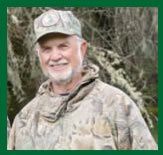Winter Hog Hunting
by Terry Knight
The California deer season is closed and after the first of the year
waterfowl and upland bird seasons wind down . That leaves hunters
with few choices. However, you can hunt wild pigs on one of
the many W.U. ranches that remain open through the winter. The
good news is that pig hunting reaches its peak during the winter
months of January and February. Actually wild pig hunting ranks
very high on the list of W.U. hunters. The reason being that the
organization has some excellent pig ranches.
. That leaves hunters
with few choices. However, you can hunt wild pigs on one of
the many W.U. ranches that remain open through the winter. The
good news is that pig hunting reaches its peak during the winter
months of January and February. Actually wild pig hunting ranks
very high on the list of W.U. hunters. The reason being that the
organization has some excellent pig ranches.
Wild pigs can be identified from their domestic cousins by their long snouts and heavy shoulders with small hindquarters. They are very wary and shy. They have poor eyesight, but excellent hearing and an incredible sense of smell. Many hunters consider an old boar as one of the wariest critters in the woods. If a pig catches a human’s scent, it will immediately spook and usually won’t stop for a mile or more.
The presence of wild pigs can be found by the telltale signs they leave such as rooting and droppings. Fresh tracks are another indicator of pigs being in the area. However, hunters often confuse deer tracks for pig tracks. In comparison to a deer track, which is long and oval, a pig track is short and wide. If there are a lot of pigs in the area you will also see many very small tracks. These are from the piglets in a litter. Wild pigs are constantly on the move—often traveling up to 20 miles within a few days. It’s not unusual to see fresh pig sign in an area, then nothing for the next few weeks. The primary factor is the availability of food. They eat just about everything from tubers, nuts and insects to carrion. An adult boar will also travel long distances looking for a sow in heat. Sows and their litters, plus other young pigs, normally travel in small groups. Sows will breed throughout the year and each litter will produce three to six young. The youngsters are striped when first born, but the stripes disappear after about five months. A herd of pigs is quite vocal—making grunts and squeals. Often you can hear them before you actually see them.
Pigs are most active at daylight and the last hour before dark. During the day they tend to “hole up” in heavy cover. However, if a storm or cold weather hits, the pigs will be out feeding throughout the day. Most hunters use the spot-and-stalk technique when hunting pigs. They walk the hillsides and glass for pigs feeding out in the open and then make a stalk. Using the wind to your advantage, you can often stalk to within 30 yards of a wild pig. They don’t pay a lot of attention to noise, although a human voice will alert them and they will be gone in a second. Other times, two or three hunters will team up and have one hunter walk through the canyons or other cover to flush out the pigs.
The standard deer rifle is fine for pigs. Since they are built so low to the ground, most experienced hunters won’t shoot at a running pig. In fact, many guides won’t allow their clients to shoot at running pigs because of the fear of only wounding it. The average wild pig will field dress at about 130 pounds. A mature boar can weigh as much as 300 pounds but they are rare. In fact, most hunters don’t want to kill a tough old boar. The ideal eating size is either a young dry sow or boar in the 130- to 160-pound range. A pig that size will yield about 65 pounds of meat, cut and wrapped.
Once you have a pig down, the hard work begins. A pig generates a lot of body heat and should be field dressed as soon as possible. The next chore is to skin it. Hang the pig by its hind legs and skin it much like you would a deer. Another method is to cut long five-inch strips down the carcass and pull off the hide in sections. I always recommend that hunters locate a butcher prior to going hunting. Because of strict state health regulations on handling meat, most butchers no longer process wild game.
